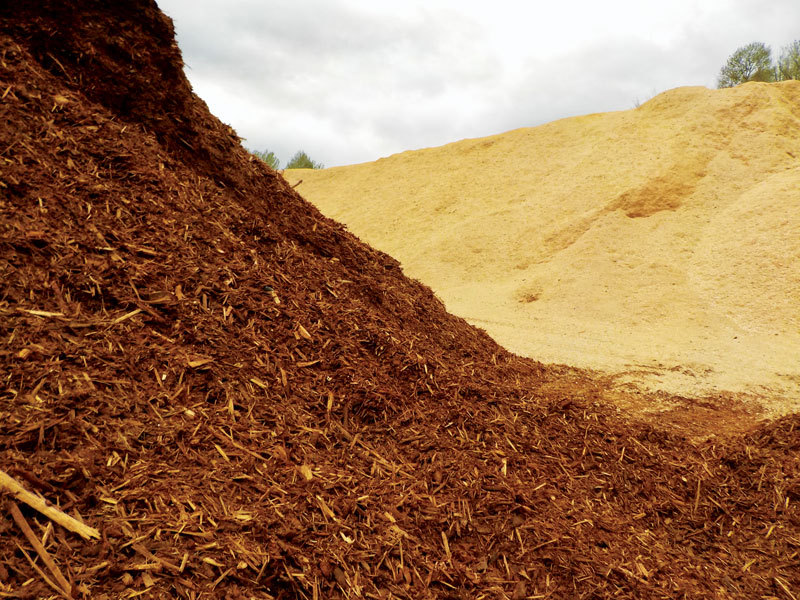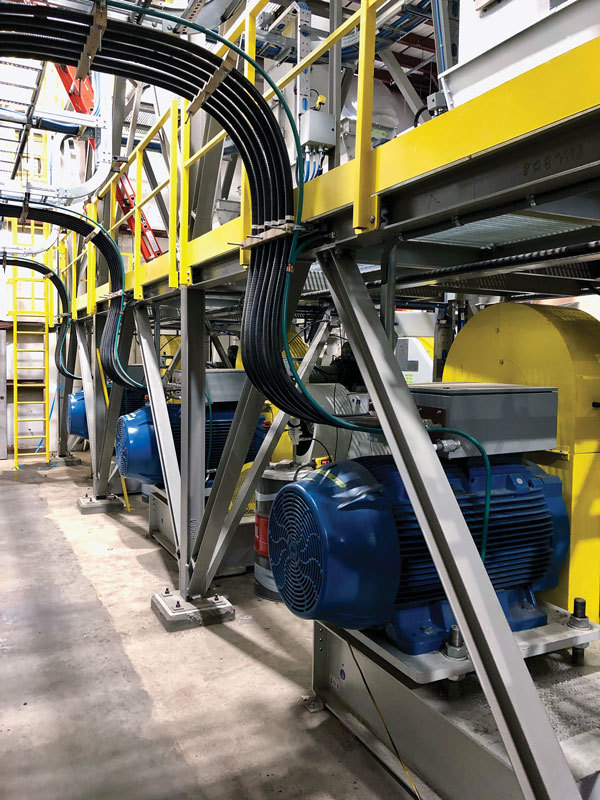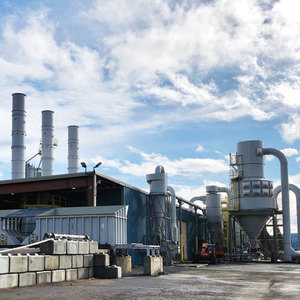Saving A Sawmill










PHOTO: SKEENA BIOENERGY LTD.
May 22, 2019
BY Ron Kotrba
In April, Skeena Bioenergy Ltd. began commissioning its brand new pellet plant in the forested, mountainous West Canadian terrain of Terrace, British Columbia. Construction on the pellet mill began just nine months prior in an existing, vacant building on a site adjacent to Skeena Sawmill Ltd.’s operations. Local pioneer Bill McRae originally built the neighboring lumber mill in 1960, after which it changed hands a number of times through the years.
The latest acquisition of the sawmill was in 2011, when Roc Holdings Ltd. bought the business from West Fraser Timber Co. Roc Holdings is an investment company established by Teddy Cui, an emigrant with enterprising in his blood, as he hails from a wealthy, entrepreneurial Chinese family. Since acquiring the shuttered business, Roc Holdings restarted operations in 2013 and invested in major upgrades to the lumber mill and planer.
The sawmill produces planed lumber of various dimensions, from 45 millimeters (mm) thick to between 90 and 300 mm wide and 2.5 to 6 meters long. “A vast majority of our lumber business is in China, so we produce metric dimensions for that market,” says Roger Keery, vice president of operations for Skeena Sawmill and president of Skeena Bioenergy. While the Chinese market absorbs a vast majority of Skeena’s lumber supply, the mill also manufactures product for other Asian markets, including Taiwan and Hong Kong. On occasion, Skeena fulfills North American orders in Imperial, or standard, dimensions as well. In addition to planed boards, Skeena makes large green posts and timbers sized up to 12x12 inches. “We still have large logs in the area, so those products fit our log profile,” Keery says. “We try to take advantage of that.” The predominant tree species in the region are Hemlock and Balsam Fir. “Those constitute about 85 percent of our standing forest, and that’s the species group we solely process,” Keery says.
Skeena Sawmill currently processes 400,000 cubic meters of timber per year on two lines with one-and-a-half shifts per day. “We have forest licenses from the provincial government to log 316,000 cubic meters per year,” Keery says. “We purchase volumes needed outside of that.” The company performs its own forestry but contracts loggers to harvest and deliver the timbers from up to 150 kilometers (km) away, with the sweet spot being under 50 km.
A New Way
When Skeena Sawmill restarted operations in 2013, the local pulp mill was closed, so a critical issue for Cui and Roc Holdings became what to do with all the residuals—80,000 green metric tons, or about 40,000 dry tons, per year—from its sawmill operations. “In the past, it had all gone to the pulp mill,” Keery says. “Now, we are quite a distance from anyone that would want to buy it. There is a high cost to transport it that far or to landfill it. We looked at a number of alternatives and we concluded that a pellet mill would be the best choice. We saw it as the first and critical step in making this sawmill business successful. We had established the business, and we attracted a good customer base and employee group, but we needed to recapitalize. The sawmilling business is very challenging in this area. This pellet plant was the first major capital investment in our operations, and the first major step to changing Skeena’s future.”
Skeena Sawmill established Skeena Bioenergy as a wholly owned subsidiary. The company contracted Prodesa to design the CAN$20 million pellet mill with a nameplate capacity of 75,000 metric tons per year. Construction began in July 2018.
Keery says beyond the sawmill residuals, Skeena Bioenergy is securing additional material from two sources. “One is we’re purchasing material from logging operations in the area, which are known, recoverable volumes,” he says. “And two, we have a whole log chipping program. The chips from whole log chipping are barged down the coast to pulp producers in B.C., but the bark and screen fines are sent to the pellet mill.”
With the pellet mill using only bark from its whole log chipping program to supplement the sawmill’s residuals, its pellets have a high bark content. “We’re vetting this concept of high-bark pellets,” Keery says. “There are two issues with bark. One is the heating value, and the other is ash content. The heating value for our bark is identical to white wood, so that’s not an issue. On the ash, we’ve spent significant time looking at this. Hemlock bark doesn’t appear to have the entrained ash other species have, and early results indicate we can meet product specifications with the higher bark content.”
Keery says approximately 11 percent of Skeena’s Hemlock wood volume is bark, which is 3 to 4 percent higher than other species. “The bark is thicker,” he says. “It’s a significant resource for us, and we have to take advantage of that.”
Skeena’s Hemlock hails from the north-central coast of British Columbia where the climate and terrain produce a lower average grade of wood, Keery says. “For us, using a lot of the lower-grade material is key to our success and business,” he says. “On the pellet side, we use all parts of the tree, including the bark. On the sawmill side, we use lower-grade logs to chip for pulp, or saw what we can to extract lumber out of them. We’ve even tested the concept of pure bark pellets and believe there is a place for this in the market. We produce an IS2-grade pellet by blending bark and white wood and will continue to experiment, being careful to ensure we can meet IS2 specs. We have the ability to blend biomass going into the pellet mill. This system is critical to managing the ash content to keep it within the IS2 limit, whether it’s 30 or 50 percent bark. The chemical analysis meets the spec.”
Prodesa built the pellet mill with separate infeed systems to control the incoming blend of feedstock. The white wood and hog bark are mixed separately and blended together to get the specified ratio required to make an on-spec pellet. From there, the blended feedstock is fed into a single Bruks hammer mill and then into a Swiss Combi gas-fired belt dryer. After drying, the product goes into a Promill dry hammer mill and is then transported via a pneumatic system with a cyclone filter into three Promill pelletizers. The freshly made pellets are then sent through cooling, screening and into a 200-ton silo set up for truck shipment.
“Our nameplate capacity is 75,000 tons, but I might add that, with three machines, others might boast a nameplate capacity of up to 120,000 tons,” Keery says. “The reason our nameplate is 75,000 tons is because we planned for significant redundancy and projected higher maintenance downtime due to the high bark content. Our runability remains to be seen, but this is why our nameplate is lower than what people might expect with three machines. If we can manage that issue, I think 100,000 tons a year is within reason with the installed capacity we have. We sized our dryer to allow us to do that. We are being conservative on our nameplate because we are not sure how the bark issue will work out in practice.”
Offtake
Pacific BioEnergy announced this winter it had secured a long-term offtake agreement with Skeena Bioenergy to purchase Skeena’s pellets. Pacific BioEnergy owns and operates a 350,000-ton pellet mill in Prince George, British Columbia. Pacific BioEnergy also has minority interests in two other pellet mills in British Columbia and, overall, it produces, purchases and manages more than 500,000 tons of pellets annually.
In July 2017, the Japanese company Sumitomo Corp. acquired 48 percent of Pacific BioEnergy. “Sumitomo is a major player in the Japanese wood pellet market,” says John Stirling, president of Pacific BioEnergy. “Sumitomo controls a significant volume of pellets in the utility market in Japan with dedicated biomass power plants as well as cofiring opportunities. For them, they really wanted to have a good footprint in that market, so they decided it was very useful for them to invest upstream.”
Stirling says about 80 percent of Pacific BioEnergy’s 500,000-plus tons of pellet supplies are destined for Japan, with the remainder going to Europe. “In the past three to four years our market focus was shifting to Japan,” he says. “It’s a significant market with a lot of room for growth.” Stirling says even though the trend to move its supply to Japan was well underway when Sumitomo joined Pacific BioEnergy, its investment “accelerated” this development.
“The Skeena pellet volume is currently flowing into our existing customer base as the operation starts up,” Stirling says. Pacific BioEnergy just received and unloaded its first railcars full of Skeena Bioenergy pellets at the Fibreco Export Inc. terminal in North Vancouver.
Keery says Skeena looked at the option of taking on partners prior to its decision to build the pellet mill, but ultimately the company decided to finance the plant alone so as to not give up equity. “Once we made that decision, we moved to plant design and construction, and then we went looking for customers for our product,” Keery says. “We hired marketing consultant Brodie Govan of Voyage Power to help us. He and Rick Harris, vice president of sales and marketing for Skeena, found three customers prepared to give firm quotes. We felt the best offer was from Pacific BioEnergy.”
The offtake agreement is a multiyear contract with a renewal option. “It’s a great arrangement and we’re really happy with it,” Keery says. “That said, the pellet market in Japan is very robust with plenty of potential buyers, but it’s important to find the right ones. The most challenging aspect of the business is the logistics of getting our product to the customer. Customers want reliability and scale, and we are pretty small in the sector. So for us to be a part of a bigger volume with Pacific BioEnergy allows us to ship our product by bulk cargo vessels carrying 30,000 to 40,000 tons, which is six to eight months of Skeena’s production.”
Pacific BioEnergy has its own dedicated fleet of railcars and a reliable port terminal through Fibreco in North Vancouver. Stirling points out that Pacific BioEnergy’s railcars move back and forth from the Terrace area to the Fibreco port where Skeena’s pellets are merged with other supplies and sent to Japan.
“Smaller companies don’t have the ability to fill ships, so contracting with us provides them with a good, steady takeaway, good and reliable pricing and good payment terms,” Stirling says. “It makes sense for them to tap into the scale and infrastructure we have. We also have a lot of market intelligence, so they get the advantage of all of this.”
Furthermore, Stirling says what also helped Pacific BioEnergy land the offtake contract with Skeena was the people working on the deal. “I think what made the difference is we had good people working on all sides—Roger and Rick from Skeena, and Paul Kalil, our vice president of capital projects, and Sumitomo’s Takayasu Nakamura,” Stirling says. “Taka and Paul spent time developing a good relationship with Rick and Roger. What they liked about us is that our operations are relatively close by, and that we have very similar business styles. We had a good meeting of the minds. I think what also helped is the fact that Sumitomo invested here in British Columbia, and Skeena Sawmill is Asia-focused with its markets in China, and they were willing to work with us to put contracted volumes into the Japanese market.”
While Pacific BioEnergy is buying virtually all of Skeena Bioenergy’s pellets, a provision exists in the contract that includes a small carve-out for local heating market sales. “We want to support that, and they do too,” Stirling says. Keery adds, “We strongly believe we should service the local retail market. This is a very small volume at present, but it is important to the community and outlying towns where natural gas is not available.”
Pushing Through
Navigating the unknowns of a new business sector has been challenging, but Keery says thanks to the expertise of hired personnel, the process has been rewarding. “We’re thrilled with the people we hired,” Keery says. “They’re critical to our success.” The establishment of the new pellet mill generated 16 new jobs so far for the Terrace area. Keery says training is underway and, as the plant increases shifting, four more jobs will likely be created.
The regulatory challenges have been daunting at times, Keery says, but the end result is an ultraclean process. “Often there is no visible discharge from the plant stacks,” he says. “When the dryer is running on a warm day, you can see nothing coming out of the plant. One of our neighbors, a truck repair shop, wasn’t even aware we started up.”
Another hurdle to overcome well after project development began was the inception of the sustainable biomass partnership program. “During the course of construction, the industry agreed not to mix certified and noncertified pellets,” Keery says. “This went into effect March 30, so we had to get certification. We started the process in January and just received our certification in late April.” These include chain of custody and sustainable biomass certifications.
Financing the $20 million project proved to be an interesting endeavor, particularly so thanks to contemporaneous geopolitical world events. “Our owner Teddy Cui financed the project through the bank his family business works with in China,” Keery says. “During the project, the Huawei executive was charged here and the current trade conflict with China began. A consequence of this was our funding was restricted about two months before the project was finished. Our owner had to scramble to find alternate arrangements and we had some really difficult times with payables. It took some time, but we managed to get this sorted out, pay everyone and complete the project. Our contractors and suppliers continued to support us through this, and we certainly appreciate it.”
As Skeena Bioenergy moves forward with commissioning in April and into May, Keery says he hopes to sign off on the acceptance test for the plant with Prodesa by late May. “We’re still commissioning, but we’re right in the middle of transition,” he says. “We have a punch list of things to address. On the operations side, we are crewed for five-day weeks, and we are training all operators. We’re sorting through the glitches in the system but we are producing. I’ll be happy if we hit our 75,000-ton run rate this year.”
Author: Ron Kotrba
Senior Editor, Pellet Mill Magazine
218-745-8347
rkotrba@bbiinternational.com
Advertisement
Advertisement
Upcoming Events





